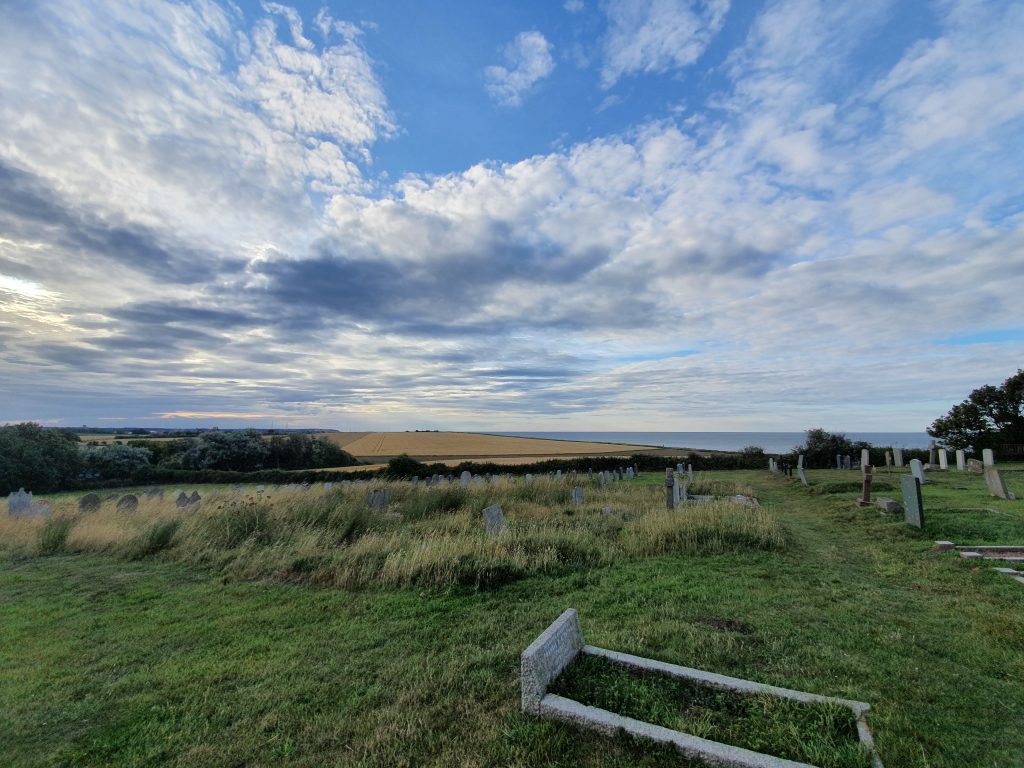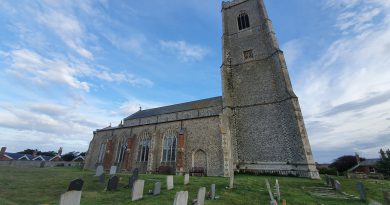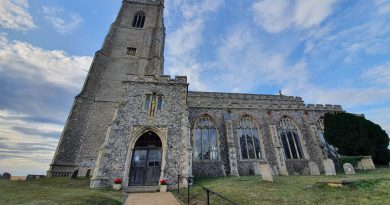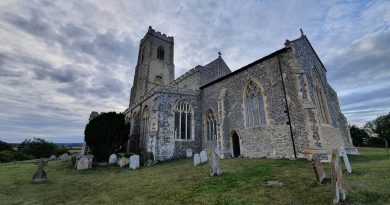Happisburgh – St. Mary’s Church (HMS Invincible Memorial)
This memorial is in a prominent position in the churchyard of St. Mary’s church in the coastal town of Happisburgh.
HMS Invincible was launched on 9 March 1765 and was used in the American War of Independence. She was sailing from Great Yarmouth on 16 March 1801 when she hit the sandbank off Happisburgh known as the Hammond Knoll Rock. Although the admiral and 195 sailors were saved, around 400 men lost their lives. The harbour pilot, who died when the ship sank, was later blamed for the incident, which was one of the worst maritime events of the eighteenth century.
This memorial stone was added here in 1998 as by chance when digging a drainage channel in the churchyard, the bodies of many of the ship’s crew were discovered. It was known that there had been a large communal grave, with carts bringing the bodies to a section of land located just off the main churchyard, but the exact spot of the burials wasn’t previously known. They were buried just three feet under the surface, with no real order to the remains.
This letter was written by one of the sailors on board:
“Only two days have elapsed since I last wrote to you, and in that short space the most melancholy accident has happened, namely, the total loss of our ship. We set sail from Yarmouth on Monday morning for the Sound, to join the fleet under the command of Admiral Sir Hyde Parker; and about two o’clock in the afternoon the ship struck on a sand-bank, where she beat most violently for upwards of two hours, when her masts were cut away, and her anchor was then cast, and we all thought our selves safe; for, notwithstanding she leaked considerably, the water gained but little upon us. Our signals of distress were heard and answered by a cutter, which immediately bore down to Yarmouth, to give intelligence of our distress; and we therefore hoped, with the assistance that should arrive, to be able to save the ship as well as ourselves; but God ordained it otherwise.
The rudder being unfortunately gone, the ship became unmanageable, and in the evening she again drove on the bank, when we all gave ourselves up for lost. Through God’s providence, however, a fishing smack, at this awful juncture, hove in sight, and the admiral; my self, and two or three more, succeeded in getting on board of her; but the rest, in endeavouring to do the same, lost all the boats they were able to get over-board. In this melancholy condition she remained till the following morning, when, shocking to relate, she entirely sunk; we being all the time spectators of the distressful scene, without any possible means of affording the sufferers the least assistance, as any attempt to that effect would only have involved ourselves in the general calamity. By God’s providence, however, the ship’s launch, full of men, at length got clear of the wreck, and by her assistance we were enabled to save some others. In the whole, about 195 are saved.
The greater part of the officers, including the captain, have unfortunately perished.”
The Invincible was heading towards a fleet led by Norfolk’s hero Horatio Nelson when it sank, and the great admiral himself visited Great Yarmouth to see some of the injured crew who had survived. Today, there’s a play park near the church named HMS Invincible Park, a reminder of the sad event which cost so many men their lives.





